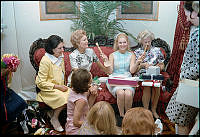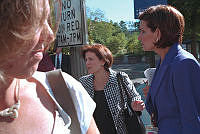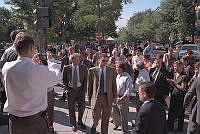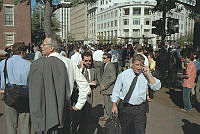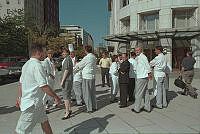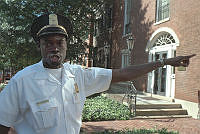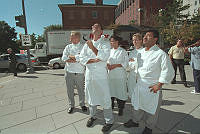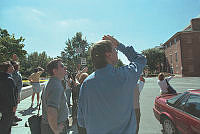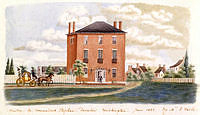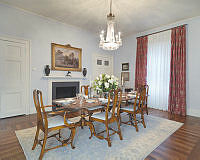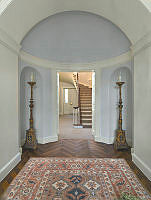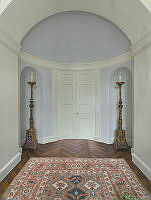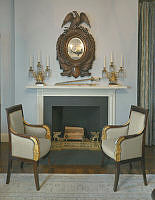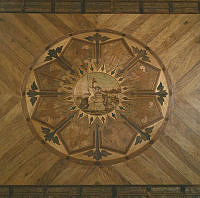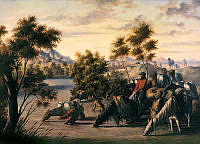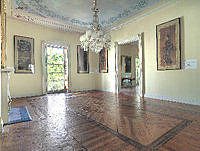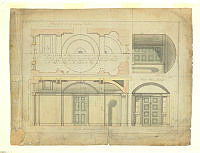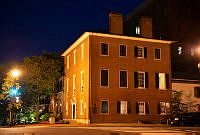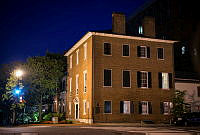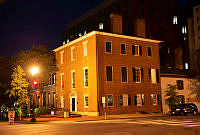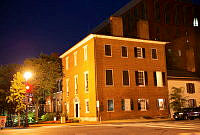Rubenstein Center Scholarship
Baron and Baroness Hyde de Neuville and Decatur House
One of America’s most celebrated naval heroes, Stephen Decatur, died on March 22, 1820 from wounds sustained in a duel with Commodore James Barron. Decatur’s tragic loss also confronted his 44-year-old widow Susan with the problem of how to maintain their new home near the White House, known as “Decatur House,” a fashionable three-story Federal town house designed by master architect Benjamin H. Latrobe and completed in 1819.
Left in a vulnerable financial condition by her husband’s death, Susan Decatur raised money by auctioning most of the home’s furnishings, then moved to a small frame house on N Street in Georgetown and rented the Decatur House. Her first tenants were a remarkable couple, the French Minister to the United States, Baron Jean-Guillaume Hyde de Neuville (1776-1857) and his wife, the Baroness (c. 1761?-1849). Their tenancy ushered in a distinguished list of diplomats and statesman as Decatur House residents, including the Russian minister the Baron de Tuyl (1822-1827), British minister Charles Vaughn (1834-1835), and Secretaries of State Henry Clay (1827-1829), John Quincy Adams (1829-1831), and Edward Livingston (1831-1833).

This painting is an early view of the White House and the first executive office buildings, 1821.
I.N. Phelps Stokes Collection of American Historical Prints, New York Public LibraryBorn Anne-Marguerite-Henriette Rouillé de Marigny, she married the royalist Baron Hyde de Neuville in July 1794 at the height of the French Revolution’s Reign of Terror. In 1803 Hyde de Neuville was charged with being part of a plot to kill Napoleon and was labeled a fugitive, subject to capital punishment. His wife displayed great bravery in trying to persuade government officials that her husband was innocent. She managed to follow the French army across Europe to obtain a hearing with Napoleon himself, who was so stirred by her courage that he reduced Hyde de Neuville’s sentence to one of banishment.
The de Neuvilles spent some time in Spain before landing in New York City in June 1807; they made their home there and also spent time in upstate New York and the Hudson River Valley. Beginning in 1811 they made a summer home on a farm near New Brunswick, New Jersey, where they raised merino sheep. In New York City the de Neuvilles helped organize a school in 1810 for both male and female French émigrés from the Caribbean. They also journeyed widely throughout the nation that had given them refuge and the Baroness, a gifted watercolorist and painter, often had a sketchbook available to chronicle the people and places she had seen.

De Neuville’s watercolor of F Street, N.W. in Washington illustrated the one-story frame and two-story brick houses with gardens that once stood alongside commercial and government buildings, including Rhodes Tavern, Little Hotel, Blodgett’s Hotel, and the Treasury and State Departments, 1821.
After Napoleon’s defeat and abdication, the de Neuvilles arrived back in France in July 1814, and in 1816 the restored Bourbon king, Louis XVIII, appointed Baron Hyde de Neuville Minister to the United States. The de Neuvilles returned to France for a four-month visit in 1820, and on their trip back to America in November 1820, the Baron observed: “I was surprised to find my wife much more inclined to cross the Atlantic again than I was. Our long residence in Washington had brought her friendships that it was pleasant to renew.”
The Baron and Baroness returned to Washington in February 1821, moved into Decatur House by January 1822 and stayed until early 1823. Mrs. Decatur obtained a loan to build a service wing in 1822 for the house extending west on H Street to accommodate a larger kitchen, service facilities, and bedrooms for members of the French legation staff.
John Quincy Adams, then serving as Secretary of State, called the Baroness “a woman of excellent temper, amiable disposition, unexceptionable propriety of demeanor, profuse charity, yet of judicious economy and sound discretion.” The de Neuvilles enjoyed entertaining and were superb hosts; the Baroness invariably told arriving guests: “I am charming to see you.” Margaret Bayard Smith, the indispensable chronicler of early 19th century Washington society, said of the Baroness: “I have seen no stranger this winter for whom I feel so much interest as Madm. Neuville. I could love her, if our intercourse could be social enough to allow it. They have company I believe almost every day to dinner, or of an evening.”

Baroness de Neuville painted St. John’s Church and the Richard Cutts House from a third floor window at Decatur House, Washington, D.C., 1822.
The de Neuvilles lived in Decatur House as Lafayette Square and the adjoining neighborhood began its development into one of the city’s most fashionable and prominent neighborhoods. The first building bordering the square was St. John’s Church, designed by Latrobe, and built in 1816. At the time Decatur House was ready for occupancy in 1819, it became the first private residence in the White House neighborhood. The house of Dolley Madison’s brother-in-law Richard Cutts at H Street and Madison Place on the square’s northeast corner was finished by 1820. Proximity to the White House attracted members of the Cabinet, Congress, the diplomatic corps, bankers, and businessmen to build, buy or rent houses on “President’s Square.” For more than 190 years, diplomats, statesmen, businessmen and high society have gathered at Decatur House to celebrate and mingle in the shadow of the White House.












